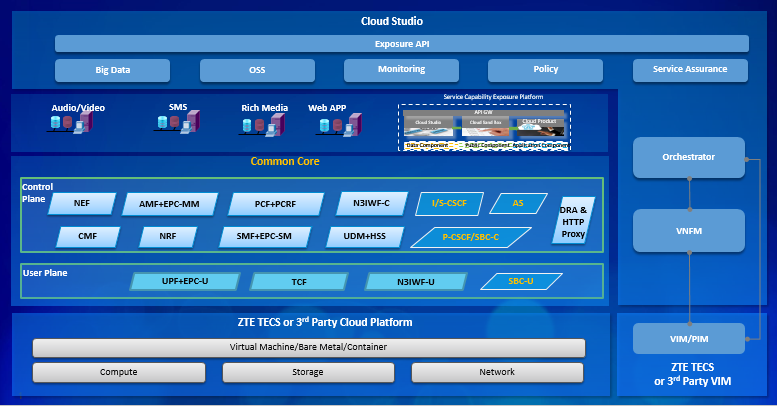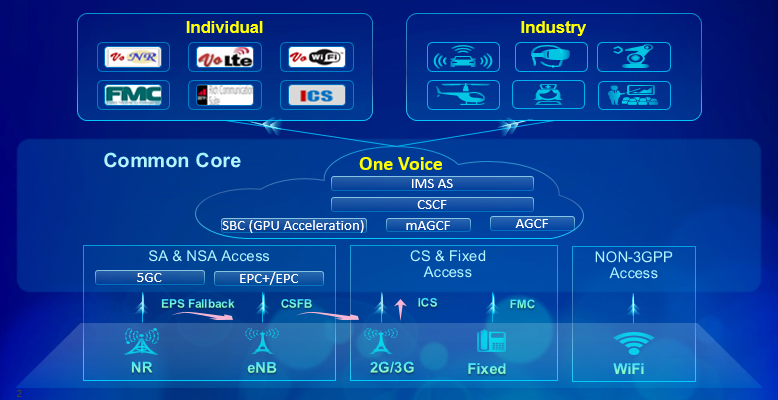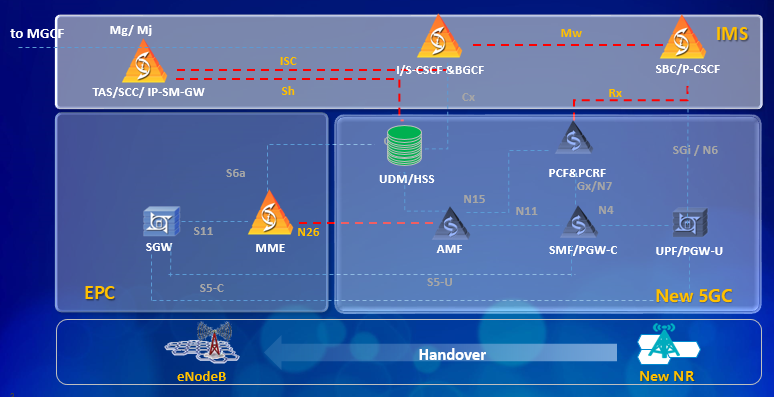Overview
It is well-known that the 5G system supports two networking modes: NSA and SA. The 5G system mainly considers economy and can directly use the existing 4G core network to protect existing investment. 5G core network needs to be built to provide high-performance services for users.
In June 2018, 3GPP R15 standard was completed, which was the first commercially available 5G version. In June 2019, 3GPP R16 Version Phase 2 was successfully frozen (The phase-3 protocol is expected to be frozen in March 2020). It is a 5G version adapted to various application scenarios.
No matter whether the standard is in NSA mode or in SA mode or whether it is an R15 version or an R16 version, voice is the most basic communication service capability. With the evolution of the 5G system to a service-based architecture, 5G voice service will gradually break through the traditional communication modes that are only oriented to individuals or groups, and effectively expand the broad industrial application market.
5G Voice Solution
One-Core-for-All System Architecture
Based on the virtualized 5G network architecture, ZTE proposed the One-Core-for-All system architecture of the fully-converged core network based on Common Core (including One Voice, One Data, One Policy and One User Plane), as shown in Figure 1.

Figure 1 ZTE One-Core-for-All System Architecture
This architecture supports 2G/3G/4G/5G/Wi-Fi integrated access and multi-type terminals, multi-system full service and user data integration, and integration of 4G and 5G signaling networks. It supports traditional telecommunication services and new IP media communication services, and customizes the deployment of industrial applications as required. In addition, it supports making integration of design, commissioning and O&M, providing closed-loop service guarantee based on the large data analysis and strategy, and implementing end-to-end visual O&M of voice.
In terms of network function, this architecture integrates the forwarding plane, control plane, policy plane and user data plane. Through unified control and forwarding, it implements session sharing, resource sharing, management sharing, unified anchor of 4G/5G user data, unified policy control and unified data authentication, simplifies the network topology, reduces the mutual operation between NEs, and reduces the network switching latency.
In terms of network mode, this architecture supports both SA mode and NSA mode, and allows dynamic adjustment of how to allocate resources between NSA and SA. The operator can flexibly select network construction modes as required. Even if the NSA is selected at the initial stage, the network can evolve smoothly to the SA in the future, improving resource utilization, reducing repeated investment, and lowering construction costs.
One Voice Solution
As an important part of ZTE's One-Core-for-All system architecture, the One Voice solution is responsible for providing voice services, and supports application modes such as large-capacity deployment, regional centralized deployment, CUPS deployment and SDN networking. The basic architecture of this solution is shown in Figure 2.

Figure 2 ZTE One Voice Solution
Through an IMS network, the One Voice solution can:
1. Provide integrated voice services such as VoNR, VoLTE, VoWiFi, VoBB and CS voice services, as well as HD voice/video, video conferencing and multiple multimedia value-added services. It provides real-time communication services such as IoV voice and AR/VR communication for vertical industries. At the same time, it exposes the network capability to the third party partners, and quickly introduces new value-added applications to build an innovative ecosystem.
2. Provide unified access control for 2G/3G/4G/5G/Wi-Fi and fixed network terminals downwards, without interrupting smooth service handover; 4G users can access the 5G voice network without changing their cards or numbers. In addition, VoNR and VoLTE can provide services in an integrated mode, greatly improving user experience.
3. Implement end-to-end O&M capabilities, and support closed-loop service guarantee and voice end-to-end visual O&M based on data analysis and policy. The system provides the design, commissioning, and O&M integration capabilities, and introduces the instant user-level voice slicing analysis technology and multi-dimensional intelligent voice perception analysis method to evaluate voice perception in a low-cost, all-call, and end-to-end manner.
Influence on the Existing IMS Network
3GPP has clarified that 5G still provides voice services based on the IMS network, and 5G voice services do not change the IMS architecture. Only some functions and interfaces need to be adjusted. The VoLTE network and the 5G voice network guarantee the continuity of voice services, especially in the early stage of 5G network construction, as shown in Figure 3.

Figure 3 Influence of 5G Voice Applications on the Existing IMS Network
The key technologies involved include 4G/5G voice continuity (interoperation), domain selection, EPS fallback, emergency call, QoS policy, user information acquisition/transfer and international roaming.
The IMS needs to modify the Rx, Sh and Gm/Mw/ISC interfaces, and add parameters such as 5G access type and user location information. When EPS fallback occurs, the SBC, SMF and PGW-C need to work together to establish a new 4G voice bearer channel independently. In the dual registration scenario of 5G subscribers, the SCC AS implements the T-ADS enhancement policy.
Suggestions on 5G Voice Network Deployment
At present, 5G voice network may adopt three deployment solutions: VoLTE/CSFB (NSA), EPS fallback (SA) and VoNR (SA). The deployment solution can be selected flexibly according to different application scenarios.
1. VoLTE/CSFB solution: If the operator has a mature 3G/4G network and hopes to rapidly provide limited 5G services for users in a low cost manner, the new 5G NR can access the existing EPC and use the VoLTE/CSFB solution to provide voice services. In this case, 5G is only a new user access mode (and the IMS/CS cannot identify 5G users, but these users are still regarded as 3G/4G users). The voice service processing mechanism is the same as that of the existing 4G network.
2. EPS fallback solution: If the operator has a mature 4G network but does not pursue 5G services at a short and low cost, the new 5G NR can access 5GC to provide data service. When voice service is required (generally triggered by NR), it can fall back to the EPC through EPS. The voice service processing mechanism is similar to the existing 4G network (but the IMS can identify 5G users).
3. VoNR solution: If the operator does not have a mature 4G network, but wants to provide high-quality 5G services for the users, the new 5G NR can access 5GC in one step and use the VoNR solution to provide voice services. The voice service processing mechanism is based on a brand-new 5G network and is not related to 4G networks (unless a handover from 5G to 4G occurs).
Conclusion
On November 1, 2019, China officially entered the commercial 5G era. In terms of technologies, standards, network deployment, and industrial ecology, 5G has achieved stage-by-stage results, providing powerful new momentum for economic growth, people's livelihood improvement, and social progress. In this booming construction activity, ZTE will, as always, provide better services for customers and strive for a more stable market position.
ZTE Common Edge enables 5G network
Intelligent Penetration Test Boosts 5G Security
ZTE Full-Scene UPF, Simplified and On-Demand
Build new IP interworking gateway offices to promote the deployment of IMS in all networks
5G Standards are Becoming Mature with Smooth Development of R16 and R17
Flexible and Highly-efficient MEC Distribution Solution Enables Industry Customers to Customize a Private Virtualized Mobile Network
ZTE Promotes the Performance and Efficiency of Servers and Storage to Help Enterprises Dig Deeper into Data Value
5G Operations Get Smarter When AI and Slicing Combine
Virtualized User Plane I/O Performance Acceleration Technology Boosts 5G Network
Whether Deployment is Centralized when VoLTE is Virtualized?

